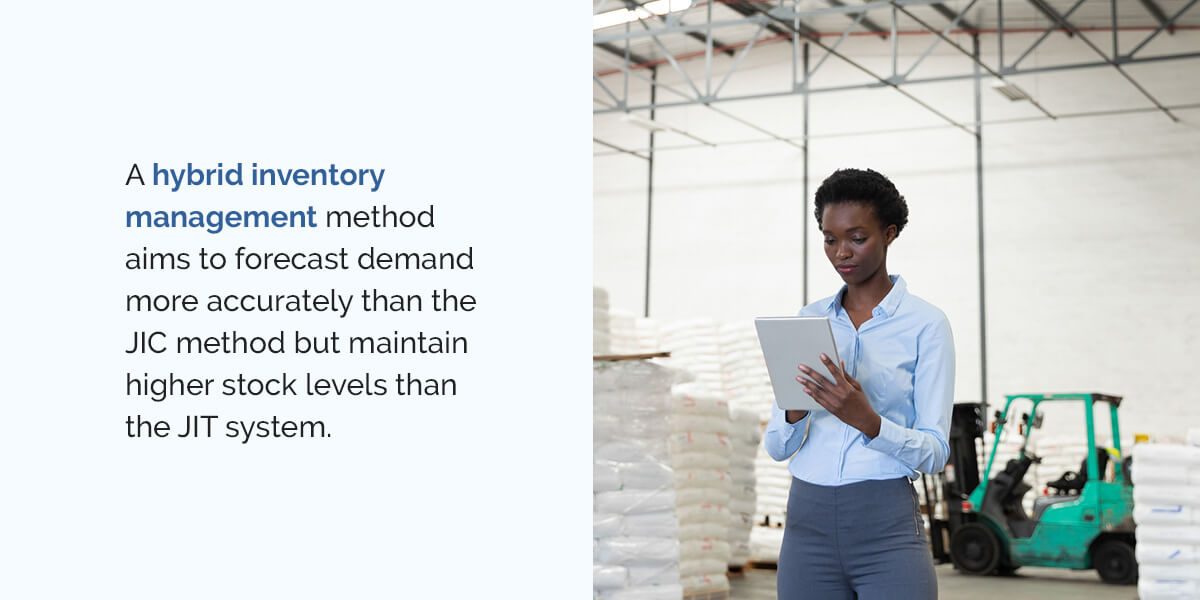Just-In-Time vs. Just-In-Case

May 19, 2023
An emphasis on supply chain cost-efficiency led many companies to use the just-in-time inventory management method for years. While just-in-time inventory can significantly reduce costs, the COVID-19 pandemic illuminated several weaknesses of this method. An over-reliance on suppliers and difficulty meeting demand fluctuations forced companies to reevaluate their strategies. Many switched to just-in-case inventory, which focuses on lowering risk with less concern for cash flow difficulties.
Despite its benefits, just-in-case inventory may not help businesses accurately meet customer demand. Instead of committing to one or the other, balancing the two inventory management methods could help you optimize your supply chain like never before. Compare the just-in-time vs. just-in-case systems and determine how you can benefit from both by creating a hybrid strategy.
Just-In-Time
It is critical for supply chain managers to understand what just-in-time inventory management is. This inventory management method, also called JIT inventory, keeps as little stock as possible and orders inventory only when customers place orders. In the just-in-time system, once a customer places an order, the business orders the precise quantity of items. Just-in-time inventory aims to fulfill orders on time while keeping the smallest amount of stock on hand to minimize storage costs and create a lean production process.
Pros and Cons of Just-In-Time
The just-in-time inventory management method can provide companies with several advantages. Consider these benefits of JIT inventory:
- Reduced holding costs: JIT inventory management reduces excess inventory, lowering holding costs and ensuring resources aren’t sitting idle in warehouses. For example, automotive manufacturers use JIT inventory to avoid storing bulky components such as engine blocks and save money buying items they need.
- Lowered waste: Just-in-time inventory reduces the risk of overordering and accumulating excess stock, allowing you only to buy necessary inventory and ensure your supply is high-quality.
- Protected investments: When comparing just-in-time vs. just-in-case inventory management, just-in-time requires less working capital. This method reduces risk by only paying for items you know will sell.
Despite these pros, just-in-time inventory may also have some cons:
- Reliance on supplier stability: JIT inventory relies on high-performing suppliers. When suppliers faced supply chain disruptions due to the COVID-19 pandemic and geopolitical tensions, companies using just-in-time inventory experienced delays. This situation can result in customer dissatisfaction and lost revenue.
- Inability to meet demand fluctuations: JIT also relies on predictable customer demand. The system may be unable to satisfy surges in demand or handle other order alterations.
- Low in-transit visibility: When products leave the supplier, you lose visibility into their whereabouts. Low visibility makes it difficult to predict arrival times, which are critical for ensuring you receive replenishment orders before your current stock depletes.
When to Use Just-In-Time
Despite the challenges this inventory management method posed to businesses during the COVID-19 pandemic, just-in-time inventory may be the best system for some companies. Here are a few scenarios in which JIT inventory might be your best choice:
- You have strong relationships with suppliers that can reliably deliver orders.
- Your supply chain already functions on short turnaround times.
- You have dependable organizational systems and can make reliable sales forecasts.
- You have flexible plans in place for handling supply chain disruptions.
Just-In-Case
Just-in-case inventory, also called JIC inventory, is the opposite philosophy of JIT inventory. In the just-in-case inventory method, a business maintains a certain inventory level to avoid production slowdowns and out-of-stocks. JIC inventory management uses expected sale forecasts to stockpile items within specific parameters. JIC inventory aims to ensure the company can maintain efficient production and meet any demand with its in-stock inventory.
Pros and Cons of Just-In-Case
When comparing just-in-time vs. just-in-case inventory, just-in-case inventory has a few significant advantages:
- Reduced consequences of supplier delays: Just-in-time inventory can protect businesses from some of the effects of supplier delays. For example, if a supplier experiences supply chain disruptions, the company may be able to continue production as scheduled using its in-stock inventory as it waits for the replenishment order.
- Ease navigating demand fluctuations: JIC may handle surges in customer demand better because the business has a supply of inventory to address unexpected changes. JIC enables companies to meet almost any level of demand, increasing their competitiveness.
While JIC inventory offers several pros, it may also carry a few cons:
- Requires more working capital: One of the disadvantages of JIC inventory is that it prioritizes higher stock levels over the cash flow implications of holding inventory in reserve. This method ties up more of the company’s cash flow in inventory waiting for a customer order.
- Higher warehousing costs: Because JIC inventory intentionally stockpiles inventory, companies using this method will pay higher warehousing costs to maintain inventory levels.
- Wasteful if demand declines: If demand drops past a certain point, companies using JIC inventory may experience slow-moving inventory. JIC inventory management can become wasteful if stock spoils or doesn’t sell.
When to Use Just-In-Case
As with JIT inventory, JIC inventory management may be helpful to businesses in certain situations. Here are a few examples of when to use just-in-case inventory management:
- Your suppliers are unreliable and don’t deliver orders consistently.
- Your customer demand experiences frequent fluctuations and is difficult to predict.
- Your materials or raw components are subject to sudden price surges or frequently go out of stock.
How to Balance Just-In-Time and Just-In-Case
Considering the pros and cons of a just-in-time vs. just-in-case supply chain, combining the two methods may be the best option. While global supply chain disruptions hopefully will not become regular occurrences, the COVID-19 pandemic illustrated the importance of achieving supply chain flexibility. With those priorities in mind, fully committing to JIT or JIC inventory may not help companies achieve greater resilience. Instead, using a hybrid inventory management method allows you to maximize the pros and minimize the cons of both systems.
A hybrid inventory management method aims to forecast demand more accurately than the JIC method but maintain higher stock levels than the JIT system. This approach keeps inventory cost-effective while maintaining enough stock to quickly address demand fluctuations or supplier delays.
Consider the following steps for creating an effective hybrid inventory management method:
1. Perform an Inventory Analysis
Inventory analysis is an exercise where you determine which products are most essential and consider which inventory management method to use to acquire them. JIC inventory may work best for important items with quick turnover, while JIT may be best for less popular items or those in small quantities. You can use various inventory analysis techniques to determine your most to least important inventory, such as:
- ABC analysis: An ABC analysis places items in categories based on revenue and profit margins, with category A having the highest revenue and category C the lowest.
- VED analysis: This inventory analysis method categorizes items on whether they are vital, essential, or desirable to have in stock.
- HML analysis: An HML analysis classifies items by high, medium, and low cost.
2. Strengthen Supplier Relationships
Reducing supplier risk is critical when relying on their performance to maintain lean production times. To help strengthen your supply chain and ensure products arrive on time, invest in strengthening your supplier relationships. Improving your relationships with your suppliers allows you to streamline your operations, reduce inefficiencies, and manage supplier risk.
Following the supplier relationship management process can help you build mutually profitable long-term relationships with suppliers. Here are the steps to take to bolster your partnerships:
- Analyze the value of each supplier and how they impact your company’s profitability.
- Create strategies for increasing collaboration, such as implementing electronic data interchange (EDI) software to streamline document transmission.
- Design a supplier relationship management strategy and monitor progress.
3. Implement Robust Inventory Management Tools
You need powerful inventory management tools to combine JIT and JIC inventory effectively. One of the essential tools for balancing just-in-time and just-in-case inventory is Vendor Managed Inventory (VMI). VMI is an inventory model that uses shared business objectives to improve suppliers’ and distribution partners’ collaboration. VMI empowers suppliers to recommend replenishment orders based on shared data instead of requiring distributors to place orders based on customer demand.
A VMI solution is one of the most effective alternatives to JIT inventory, enabling greater visibility into product movement and customer demand to increase supply chain agility.
Balance Just-In-Time and Just-In-Case Inventory With VMI
The right inventory management model is critical for building a profitable and resilient supply chain. During the COVID-19 pandemic, many companies experienced the disadvantages of just-in-time, while the just-in-case system brings its own challenges. Implementing a hybrid inventory management model that combines just-in-time and just-in-case inventory is the best strategy for ensuring enough stock to maintain production times and meet demand while reducing warehousing costs.
Combining JIT and JIC inventory with a supportive technology like VMI can take your inventory management to the next level. With VMI solutions from TrueCommerce, you can expedite forecasting and improve in-stock rates to create a demand-driven, optimized supply chain. To learn more about our VMI solution, contact one of our VMI experts today.
Share this post:
Stay ahead of the competition
Get expert supply chain insights delivered directly to your inbox weekly.

